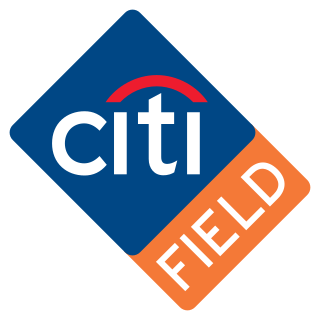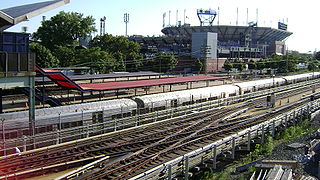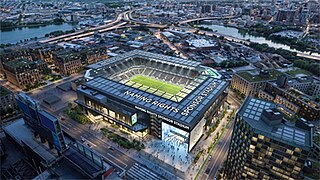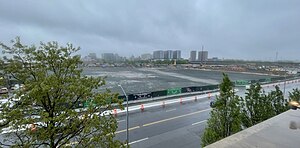
Flushing Meadows–Corona Park, often referred to as Flushing Meadows Park, or simply Flushing Meadows, is a public park in the northern part of Queens in New York City, New York, U.S. It is bounded by I-678 on the east, Grand Central Parkway on the west, Flushing Bay on the north, and Union Turnpike on the south. Flushing Meadows–Corona Park is the fourth-largest public park in New York City, with a total area of 897 acres (363 ha).

A strip mall, strip center, strip plaza or simply plaza is a type of shopping center common in North America and Australia where the stores are arranged in a row, with a footpath in front. Strip malls are typically developed as a unit and have large parking lots in front. Many of them face major traffic arterials and tend to be self-contained with few pedestrian connections to surrounding neighborhoods. Smaller strip malls may be called mini-malls, while larger ones may be called power centers or big box centers. In 2013, The New York Times reported that the United States had 65,840 strip malls. In 2020, The Wall Street Journal wrote that in the United States, despite the continuing retail apocalypse starting around 2010, investments and visitor numbers were increasing to strip malls.

The Mets–Willets Point station is a rapid transit station on the IRT Flushing Line of the New York City Subway. Located near the Citi Field baseball stadium, it is served by the 7 train at all times and by the express <7> train rush hours in the peak direction or after sporting events. This station is located near Flushing Meadows–Corona Park in Willets Point, Queens, on Roosevelt Avenue between 114th and 126th Streets.

Potomac Mills is a shopping mall located in Dale City, Virginia, in the Washington, D.C., metropolitan area. The first mall developed by the Mills Corporation, it was acquired in 2007 by Simon Property Group.

The New York City 2012 Olympic bid was one of the five short-listed bids for the 2012 Summer Olympics, ultimately won by London.

Southside Wandsworth is a shopping centre in the district of Wandsworth in London, England. When it was built it was the largest indoor shopping centre in Europe and is currently the fifth largest indoor shopping centre in London after Westfield Stratford City, Westfield London, the Whitgift Centre and Brent Cross Shopping Centre.

Citi Field is a baseball stadium located in Flushing Meadows–Corona Park, in the borough of Queens, New York City, United States. Opening in 2009, Citi Field is the home ballpark of Major League Baseball (MLB)'s New York Mets. The stadium was built as a replacement for the adjacent Shea Stadium, which had opened in 1964.

Newport is a 600-acre (2.4 km2) master-planned, mixed-use community in Downtown Jersey City, in the U.S. state of New Jersey, consisting of retail, residential, office, and entertainment facilities. The neighborhood is situated on the Hudson Waterfront on what had been the yards of Erie Railroad's Pavonia Terminal, located opposite Lower Manhattan and the neighborhood of Tribeca in New York City. Redevelopment of the neighborhood began in 1986 as a $10 billion project led by real-estate tycoon Samuel J. LeFrak and his firm The LeFrak Organization.

Mets–Willets Point is a station on the Long Island Rail Road's Port Washington Branch in Flushing Meadows–Corona Park, Queens, New York City. Prior to 2021, the station would normally be open only during New York Mets home games, the U.S. Open tennis tournament, major events, and emergencies. The station has been served full-time since 2023.

Laguna Hills Mall was a shopping mall in Laguna Hills, California, United States, in southern Orange County that is being redeveloped into a lifestyle center by the owners as Village at Laguna Hills. The enclosed mall closed on December 31, 2018, and was completely demolished in 2023. The exterior stores remain open. A hotel, entertainment venues, apartments, office spaces and a community park will replace the mall.

The Flushing River, also known as Flushing Creek, is a waterway that flows northward through the borough of Queens in New York City, mostly within Flushing Meadows–Corona Park, emptying into the Flushing Bay and the East River. The river runs through a valley that may have been a larger riverbed before the last Ice Age, and it divides Queens into western and eastern halves. Until the 20th century, the Flushing Creek was fed by three tributaries: Mill Creek and Kissena Creek on the eastern bank, and Horse Brook on the western bank.

Easton Town Center is a shopping center and mall in northeast Columbus, Ohio, United States. Opened in 1999, the core buildings and streets that comprise Easton are intended to look like a self-contained town, reminiscent of American towns and cities in the early-to-mid 20th century. Included in the design are fountains, streets laid out in a grid pattern surrounded by a continuous loop, and metered storefront parking.

Brickell City Centre is a large mixed-use complex consisting of two residential high-rise towers, two office buildings, a high-rise hotel, and an interconnected five-story shopping mall and lifestyle center covering 9 acres (36,000 m2) located in the Brickell district of Downtown Miami, Florida. Situated at the junction of Miami Avenue and Eighth Street, it spans up to five blocks to the west of Brickell Avenue and to the south of the Miami River. Contrary to the name, the development is not in the traditional downtown Miami city centre, but in the more recently redeveloped financial district of Brickell. The retail shopping and lifestyle center is operated by Simon Malls.

Westlake Shopping Center is one of the first shopping malls built in America; ground was broken in 1948 for the mall in Daly City, California, United States. It is anchored by Burlington Coat Factory, Home Depot, Ross, Safeway, Target, and Walgreens.

Landmark Mall was an American shopping mall. Located in a triangle formed by Duke Street, Interstate 395, and Van Dorn Street in Alexandria, Virginia, the mall opened in 1965 and closed on January 31, 2017. The mall was anchored by Sears, Lord & Taylor and Macy's.

Rego Center is a shopping mall bordered by the Long Island Expressway, Junction Boulevard, Queens Boulevard, 63rd Drive, and 99th Street in the Rego Park neighborhood of Queens in New York City.

Agincourt Mall is a shopping mall in Toronto, Ontario, Canada. It is located at the northwest corner of Kennedy Road and Sheppard Avenue, in the Tam O'Shanter – Sullivan neighbourhood of northeastern Toronto. It is named for the adjacent historic village and current Toronto neighbourhood of Agincourt.

Grandstand is a tennis stadium situated in the USTA Billie Jean King National Tennis Center, in Flushing Meadows–Corona Park, Queens, New York. The stadium which has a capacity to seat 8,125 people, is owned by the United States Tennis Association. The court is the third largest at the national tennis center, after the Arthur Ashe and Louis Armstrong Stadiums. Built to host the US Open, Grandstand was constructed as part of a redesign of the national tennis center and is the first Leadership in Energy and Environmental Design tennis stadium in the world. The stadium designed by Rossetti Architects and constructed by AECOM is named after a 1978 stadium of the same name.

The New York City FC stadium is a proposed soccer-specific stadium to be built in Willets Point in the New York City borough of Queens for New York City FC of Major League Soccer (MLS), who currently play home games at Yankee Stadium and Citi Field. Construction is scheduled to begin in summer or fall of 2024 and is expected to be completed in 2027.

A power center or big-box center is a shopping center with typically 250,000 to 600,000 square feet of gross leasable area that usually contains three or more big box anchor tenants and various smaller retailers, where the anchors occupy 75–90% of the total area.


























